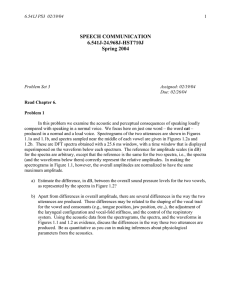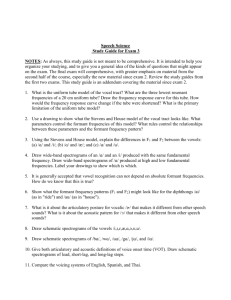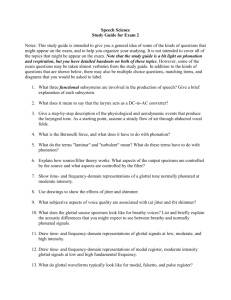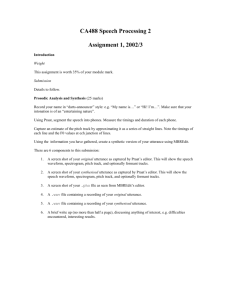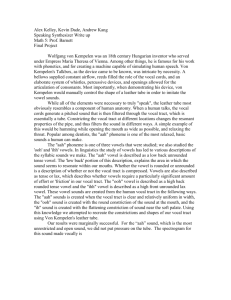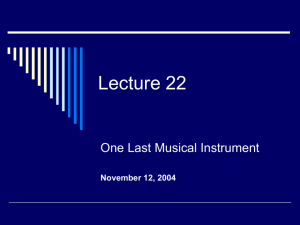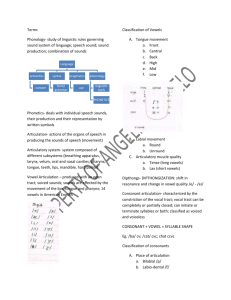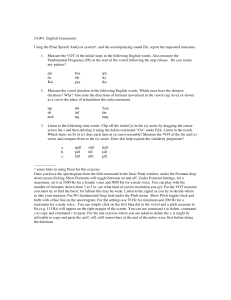(fo T Pert r tt 11
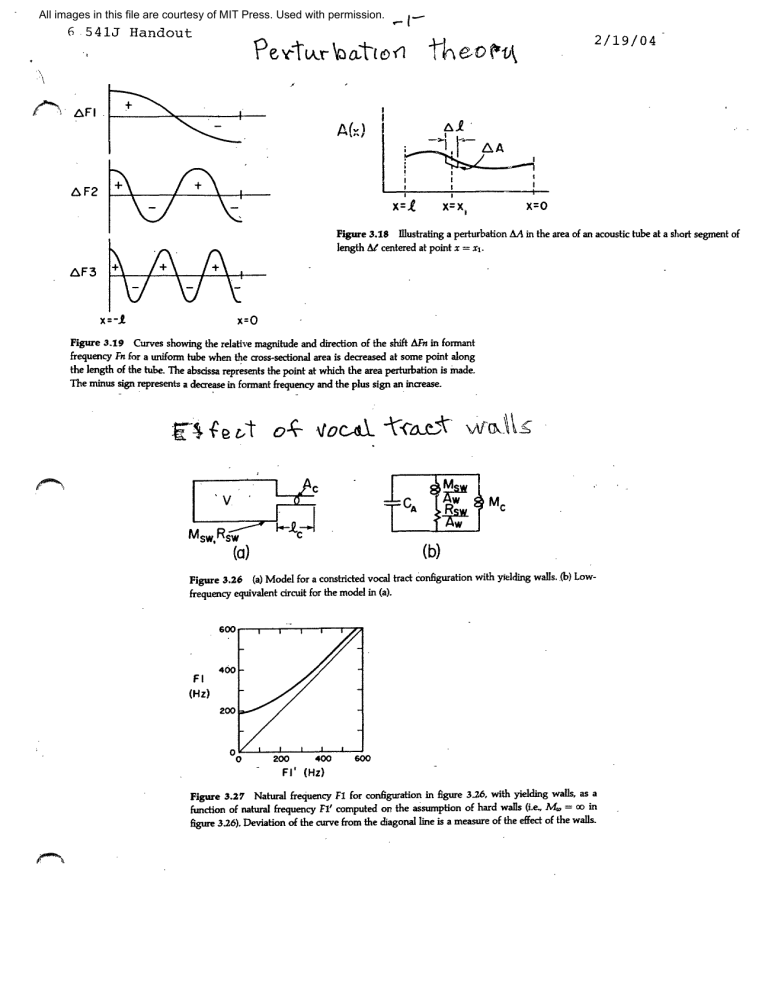
All images in this file are courtesy of MIT Press. Used with permission.
6
541J Handout
I-
Pert r tt Ofl 11
(fo
2/19/04
AF2
T
/ +\ l
I
A()
I al
-IFA
II'
I \
,
X=O x=-l
V
Figure 3.18 Illustrating a perturbation AA in the area of an acoustic tube at a short segment of length A centered at point x = xi.
AF3
n A I
V
V x=O
Figure 3.19 Curves showing the relative magnitude and direction of the shift AFn in formant frequency Fn for a uniform tube when the cross-sectional area is decreased at some point along the length of the tube. The abscissa represents the point at which the area perturbation is made.
The minus sign represents a decrease in formnnant frequency and the plus sign an increase.
o04-
ocak-
\ATC TIA&-
Mc
I
I
-w
(a) (b)
Figure 3.26 (a) Model for a constricted vocal tract configuration with yielding walls. (b) Lowfrequency equivalent circuit for the model in (a).
Fl
(Hz)
FI' (Hz)
Figure 3.27 Natural frequency Fl for configuration in figure 3.26, with yielding walls, as a function of natural frequency Fl' computed on the assumption of hard walls (i.e, M. = co in figure 3.26). Deviation of the curve from the diagonal line is a measure of the effect of the walls.
------- ---
Cj
Rsw w
(a) (b)
Figure 3.25 (a) Midsagittal section for a vocal tract configuration with closure at the lips. The resistance and mass of the walls are shown, together with the acoustic compliance of the vocal
--tract volume. (b) Low-frequency equivalent circuit .or the configuration in (a) with dosed glottis.
Aw is the surface area of the vocal tract walls, ad M, and R. are mass and resistance of walls per unit area.
Table 3.1 Calculation of contributions of radiation (B,), vocal tract walls (Bw), viscosity (B), and heat conduction (Bk) to the formant bandwidths for two different vocal tract configurations
a. Uniform tube, length 15 cm, cross-sectional area 3 cm
2
Formant frequency
(Hz).
B,
(Hz)
B.
(Hz)
B.
(Hz)
Bh
(Hz)
ToW B
(Hz)
First fornant
Second formant
Third formant
Fourth formant
592
1682
2804
3927
3
24
67
131
8
IJ
0
0
6
10
12
15
3
4
5
6
b. Resonator with dimensions in figure 3.28a, with area of opening equal to 0.32 cm 2
20
39
84
152
First formant
Second formant
Third formant
Formant frequency
(Hz)
300
1475 -
2950
B,
(Hz)
0
0
0
B,
(Hz)
28
I
0
B.
(Hz)
12
8
11
Bh
(Hz)
2
3
5
TotalB
(Hz)
42
12
16
IG
F oQ/Ocr
I-�---`�--"~~""~~--~I`���·�-·----,
I
,V,~ I',C
2,'
_
O\7ILi~l~iQIAV D %
=
L~I
I
S
S
:t I0
0
CO
U
2
·-
I I
_ · r7
I
_1·
27
27Cf,
.
I
·
I
37r
·
~~~~
·
~~~~
· ·
(0) o
0
I.-
I0
0
(b)
0
I i
1
I
.
.2
,
3
FREQUENCY (kHz) i
4
Figure 3.31 (a) Plot of magnitude of transfer function T(f) = US/LU, expressed in decibels for an ideal uniform, lossless acoustic tube, shown in figure 3.8. (b) Magnitude of transfer function
T(f) for an ideal uniform tube of length 15 cm with losses similar to those, occurring in the vocal L-act.
Figure 3.30 The lower panel shows the distribution of amplitude of sound pressure p and volume velocity U for the second natural frequency of a uniform tube, shown in the upper panel.
At points I and 3 a volume velocity source gives maximum excitation of this mode, whereas at points 2 and 4 a sourid pressure source gives maximum excitatibn. u,,
FREQUENCY (kHz)
0 1 2 3 4
FREQUENCY(kHz)
5
FREQUENCY (kHz)
Figure 3.32 Computed spectrum envelopes approximating the vowels // (left), /i/ (middle), and /u/ (right). The formant frequencies are indicated in each panel, and formant bandwidths are selected to approximate those observed in natural utterances. The ordinate is the calculated sound pressure level for each harmonic at a distance of I5 cm from the lips, assuming a funda mental frequency of 125 Hz. A smooth curve is drawn through the amplitudes of the individual harmonics. The spectrum of the glottal source is that for a male voice, from figure 2.10. The cal culated overall sound pressure levels are shown in each panel
-I---- --------
~
CorsTrvLxir i 1
(a)
aCCLh\S
5e
I
C F/'qe
-A
4 qQVj D L
$A tv1rn
?L2T( V~t~JeiX
(d B)
FREQUENCY (kHz)
(b)
· Y,
IT (f)
(d B)
20
IT(f)I
(d B)
10
U
20
,
FREQUENCY (kHz)
I I I
Figure 3.4 (a) The component of the vocal tract transfer function (in decibels) corresponding to the first formant for three different values of Fl.Note the change in amplitude of the peak and
A L~~~~~~~t· function, assuming formants above Fl remain fixed. The labels 1, 2, and 3 identify low, medium, and high values of FL.
!
I I~~~~~
2 3 4
0
-K0
-
~20 o
. ' '
Z
'
3
FREQUENCY (kHz) q
.
Figure 3.5 Computed transfer functions for three different configurations of formant frequen cies, illustrating changes in relative amplitudes of peaks and valleys in the transfer function.
Bandwidths of all resonances are fixed at 80 Hz
-· ·-----------�-----------------------------·�--�
iY-,~
UUT 1'i&
In
I LU c/t 0Y11 ~
FREQUENCY
Figure 3.2 A plot of one of the terms of equation (3.9), that is, the component of the transfer function T(s) associated with one conjugate pair of poles. The equation for this component is
T(s) = S_ S where s =j2xf, s is complex frequency of pole, and s. = a, +j2nF.. Ordinate represents mag nitude of T.(s) on a decibel scale. Abscissa is frequency f. The bandwidth of the pole for this example is approximately F/IU, so that a. F/I2r.
ITn (f)
(dB)
(a)
� -----
IT (f)I
!
(d B) 20
I I I I
V
I
(b)
0
0
.p
1 2
FREQUENCY (kHz)
3 4
Figure 3.3 (a) The components of the vocal tract transfer function corresponding to four for mants Fl, F2, F3, and F4, together with the effect of higher formants (dashed curve, labeled HP).
The sum of all these curves (in decibels), yielding the overall transfer function, is shown in (b).
-
C50 Y ym remnk Worw swt c
' bc niw &t sx
250
I. 200
-
'0
150 rn
E
100 o
50
120
00
00 0 o o o o
,
0 o
0
0 1000
o 0 o
0 1
Mab 0
2000 3000
Formant Frequency (Hz)
4000
(a)
130
120
'I
C
3
O
110
100
90
80
70
60
50
40
· Male oFemale
---...
(b)
DII
I.
200
I
300
I
400
I
500
I
600
First Formant Frequency (Hz)
I
I
700
I
800
I
Figure 6.1 Measurements of formant bandwidths for a variety of vowels with a dosed-glottis condition. The data in (a) were obtained using a sweep-tone method (Fant, .1962), and cover a range of vowel formants. The first-formant bandwidths in (b) were obtained by Fujimura and
Lindqvist (1971), also using a sweep-tone method. Average curv'es are given for male and female speakers:
19
Feb /2t
T
-7-
Is
FPQhbVoVt-
��1�1�
Figure 6.2 Midsagittal vocal tract configurations for the high vowels i/ (left) and u/ (right).
Adult male speaker of English. (From Perkell, 1969.)
Low VoUe s
Figure 6.7 Midsagittal vocal tract configurations for the non-low, non-high vowels /e/ (left) and /o/ (right). Adult male speaker of French. (Adapted from Bothorel et aL, 1986.)
'.4
Iz
0
Ii
(I, rIas FORHMANT FREQUENCY (Hz)
Figure6.16 Plotof F2 vs. FI showing how formants shift when the shape of an acoustic tube is perturbed in different ways. The midpoint represents equally spaced formants for a uniform tube of length 15.4 cm. The lines with arrows indicate how the formant frequencies change when the tube is modified as shown by the tube shapes. The comers of the diagram are labeled with vowel symbols corresponding roughly to the tube shapes. Approximate locations for the vowels /e/ and l/o are also shown. Dimensions are selected to approximate the vocal tract size of an adult female speaker.
� ___r·_�
-.
I
L) z
Z
L
Vowaes
er FSl
\
0
Z
8
-
200 400 600
FIRST FORMANT FREQUENCY
800
(Hz)
1000
English. Open circles (joined by
Figure 6.17 Plots of F2 vs. Fl for several vowels of American dashed lines) are data for adult male speakers and filled circles (solid lines) are for adult female
(1952). Data speakers. The data for the vowels /i a u/ are averages from Peterson and Barney for /e o/ are averages for two male and two female speakers.
Table 6.2 Average values of the first three formant vowels of American English produced by adult frequencies and the fundamental frequency male and female speakers for six basic
Vowel
Fl
Hz
F2
Hz
F3
Hz
FO
Hz
B0
Bark
81
Bark
82
Bark
B3
Bark
B2-B1 B3-B2 Bl-Bo
Bark Bark Bark i (emale) i (male) e (female) e (male) a (female) a:(male)
310
270
560
460
860
660
2790
2290
2320
1890
2050
1720
3310 235 2.8 3.6
3010 136 1.9 3.2
2950 223 2.7 5.9
2670 130 1.8 5.1
2850 220 2.6 8.1
2410 127 1.8 6.7
15.7 16.8 12.1
14.4 16.2 11.2
14.5 16.1 8.6
13.1 15.4 8.0
13.7 159 5.6
12 .5 14.7 5.8
1.6
2.3
2.2
2.2
\
3.2
3.3
5.5
4.9 o (female)
(male)
(female) o (male) u (female)
(male)
850 1220
730 1090
6040 120
450
370
300
1050
950
870
2810 212 2.6
2440 124 1.7
8.1
7.2
2
2.7 6.2
261 130 1.8 5.0
2670 232 2.8
2240 137
4.2
1.9 3.5
10.2
95
10
9.3
8.7
8.2
15.8 2.1
14.8
15.1
15.4
14.3
23
4.0
5.2 4.3
45
4.7
5.6
53
4.9
5.9
6.7
6.1
5.5
55
3.5
3.2
1.6
Note Frequencies are given in hertz
/iou and in bark and bark differences are are taken from Peterson and Barney (1952). also tabulated. Data for the vowels
Data for /eo/ are from a separate study with two female and two male speakers. --
_��
1__ ��_I
_I�
4 t9 Fe/ot
I
A ofl/2
'l
I _
XD
wctiort
A
2 Ial
(
I b&csa4H l/ avr\av\
(b)
'I
Figure 6.8 (a) Superimposed nmidsagittal configurations for the low vowels /e/ and /a/. (From
Perkell, 1971.) (b) Model of low vowel vocal tract shape as a concatenation of two tubes. The dashed line indicates a tapered transition between the tubes.
____�_�I�
1
4
N
I v
2
3 a,
L
0
2 4 6 8 10 12
Length of Back Cavity,
-I
(cm)
14
Figure 6.9 Frequencies of the first four natural frequencies for the nontapered configuration of figure 6.8, as the length t4 of the back cavity is manipulated. The total length 4t + z = 16 cm and the cross-sectional area A
2
= 3 cmn2. The dashed line corresponds to the case where Al <<
As, and the solid line is for Al = 0-5 cm. The radiation impedance is assumed to be zero. (From
K. N. Stevens, 1989.)
_���_____�
